Adenovirus vector
a technology of adenovirus and vector, applied in the field of adenovirus vector, can solve the problems of insufficient infectivity, insufficient gene transfection efficiency, and insufficient adenovirus vector, and achieve the effects of reducing gene transfection efficiency, high compatibility, and excellent efficiency
- Summary
- Abstract
- Description
- Claims
- Application Information
AI Technical Summary
Benefits of technology
Problems solved by technology
Method used
Image
Examples
example 1
Preparation of Adenovirus Type 35 Vector
Preparation of Plasmid
[0063] A plasmid (pAdMS1) having the SbfI recognition sequence and the NotI recognition sequence at the both terminuses of the adenovirus type 35 genome was first prepared. FIG. 1 shows the preparation procedure thereof.
[0064] When preparing pAdMS1, adenovirus type 35 (ATCC No. VR-718) was first obtained from the American Type Culture Collection (ATCC). The thus obtained adenovirus type 35 was proliferated in HeLa cells and purified via CsCl density gradient centrifugation. Adenovirus type 35 was then processed with proteinase K, thereby isolating adenovirus type 35 genomic DNA. An SbfI site was next added to the 5′ terminus of the isolated genomic DNA. The genomic DNA was processed with PacI and the resulting 2,917 b fragment was cloned into the SbfI / PacI site of a pFS2 vector. The pFS2 vector having the 2,917 b fragment cloned therein was designated as pFS2-Ad35-5. The cloned 2,917 b fragment contained the 5′ invert...
PUM
| Property | Measurement | Unit |
|---|---|---|
| structures | aaaaa | aaaaa |
| size | aaaaa | aaaaa |
| compatibility | aaaaa | aaaaa |
Abstract
Description
Claims
Application Information
 Login to View More
Login to View More - R&D
- Intellectual Property
- Life Sciences
- Materials
- Tech Scout
- Unparalleled Data Quality
- Higher Quality Content
- 60% Fewer Hallucinations
Browse by: Latest US Patents, China's latest patents, Technical Efficacy Thesaurus, Application Domain, Technology Topic, Popular Technical Reports.
© 2025 PatSnap. All rights reserved.Legal|Privacy policy|Modern Slavery Act Transparency Statement|Sitemap|About US| Contact US: help@patsnap.com



